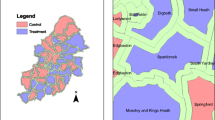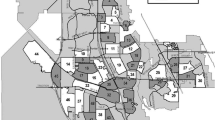Abstract
A new situational crime prevention measure recently introduced into Great Britain involves the fitting of gates to alleyways running along the back of terraced properties to restrict access to local residents and reduce opportunities for offenders. A number of quantitative techniques were used to assess the success of the intervention in reducing burglary in the City of Liverpool. The results demonstrate that, relative to a suitable comparison area, burglary was reduced by approximately 37%, there was a diffusion of benefit to properties in the surrounding areas, and the scheme was cost beneficial with a saving of £1.86 for every pound spent. The analyses provide persuasive evidence that these reductions were attributable to the intervention. We argue that the methodological techniques demonstrated here can be applied more widely to crime prevention evaluations.
Similar content being viewed by others
References
Anderson, D., S. Chenery and K. Pease, Biting back: Tackling repeat burglary and car crime, Crime Detection and Prevention Series, Paper 58. Home Office: London, 1995.
Barnes, G, Defining and optimising displacement. In: J. Eck, and D. Weisburd (Eds.), Crime and Place. Crime Prevention Studies 4, pp. 95–114. Monsey, NY: Criminal Justice Press, 1995.
Barr, R. and K. Pease, Crime placement, displacement and deflection. Crime Justice: Review Research, 12, pp. 277–318, 1990.
Bowers, K.J. and S.D. Johnson, Measuring the geographical displacement of crime. Journal of Quantitative Criminology, 19(3), pp. 275–301, 2003
Bowers, K.J., S.D. Johnson and A.F.G. Hirschfield, Pushing back the boundaries: New techniques for assessing the impact of burglary schemes. Home Office Online report 24/03. Home Office: London, 2003.
Bowers, K.J., S.D. Johnson and A.F.G. Hirschfield, The measurement of crime prevention intensity and its impact on levels of crime. The British Journal of Criminology, 44, pp. 419–440, 2004.
Budd, T., Burglary of domestic dwellings: Findings from the British Crime Survey. Home Office Statistical Bulletin 4/99. Home Office: London, 1999.
Brand, S. and R. Price, The economic and social costs of crime. Home Office Research Study 217, Home Office: London, 2000.
Clarke, R.V., Situational Crime Prevention: Successful Crime Studies. New York: Harrow and Heston, 1992.
Clarke, R.V., Situational crime prevention. In M. Tonry and D.P. Farrington (Eds.), Building a Safer Society: Strategic Approaches to Crime Prevention, Crime and Justice, 19. Chicago, IL: University of Chicago Press, 1995.
Eck, J., The threat of crime displacement. Criminal Justice Abstracts, 25, pp. 527–546, 1993.
Ekblom, P. and K. Pease, Evaluating Crime prevention. In: M. Tonry and D. Farrington (Eds.), Building a Safer Society: Strategic Approaches to Crime Prevention. Crime & Justice, a Review of Research, 19. Chicago, IL: University of Chicago Press, 1995.
Ekblom, P., H. Law, and M. Sutton, Safer cities and domestic burglary. Home Office Study 164, Home Office: London, 1996.
Farrell, G., Preventing repeat victimisation. In: M. Tonry and D.P. Farrington (Eds.), Building a Safer Society. Crime and Justice 19. Chicago, IL: University of Chicago Press, 1995.
Farrington, D.P. and B. Welsh, Effects of improved street lighting on crime: A systematic review. Home Office Research Study 251. Home Office: London, 2002.
Forrester, D., M.R. Chatterton and K. Pease, The Kirkholt Burglary Prevention project, Rochdale. Crime Prevention Paper 13, Home Office: London, 1988.
Goldblatt, P. and C. Lewis (Eds.), Reducing offending: An assessment of research evidence on ways of dealing with offender behaviour. Home Office Research Study 187, Home Office: London, 1998.
Griswold, D.B., Crime prevention and commercial burglary: A time series analysis. Journal of Criminal Justice, 12 (5), pp. 493–501, 1984.
Hesseling, R.B.P., Displacement: A review of the empirical literature. In: R.V. Clarke (Ed.), Crime Prevention Studies 2, Monsey, NY: Criminal Justice Press, pp. 197–230, 1995.
Johnson, S.D. and K.J. Bowers, Opportunity is in the eye of the beholder: The role of publicity in crime prevention. Criminology and Public Policy, 2(3), pp. 497–524, 2003.
Johnson, S.D. and C. Loxley, Installing Alley-gates: Practical lessons from burglary prevention projects, Home Office Briefing Note 2(1). Home Office: London, 2001.
Johnson, S.D., K.J. Bowers and A.F.G. Hirschfield, New insights into the spatial and temporal distribution of repeat victimisation. The British Journal of Criminology, 37(2), pp. 224–244, 1997.
Johnson, S.D., K.J. Bowers, C. Young and A.F.G. Hirschfield, Uncovering the true picture: Evaluating crime reduction initiatives using disaggregate crime data. Crime Prevention and Community Safety: An International Journal, 3(4), pp. 7–24, 2001.
Johnson, S.D., K.J. Bowers, P. Jordan, J. Mallender, N. Davidson, and A.F.G, Hirschfield, Estimating crime reduction outcomes: How many crimes were prevented? Evaluation: The International Journal of Research and Practice, 10, pp. 327–348, 2004.
Johnson, S.D, K.J. Bowers and A.F.G. Hirschfield, The impact of situational crime prevention on residents’ perceptions of risk. The International Review of Victimology, in press.
Kershaw, C., N. Chivite-Matthews, C. Thomas, and R. Aust, The 2001 British Crime Survey: England and Wales. Home Office Statistical Bulletin 18/01. Home Office: London, 2000.
McGarrell, E.F., S. Chermak, A. Weiss, and J. Wilson, Reducing firearms violence through directed police patrol. Criminology and Public Policy, 1(1), pp. 119–148, 2001.
Miethe, T.D., Citizen-based crime control activity and victimisation risks: An examination of displacement and free-rider effects. Criminology, 29(3), pp. 419–439, 1991.
Painter, K. and D.P. Farrington, The crime reducing effects of improved street lighting: The Dudley project. In: R.V. Clarke (Ed.), Situational Crime Prevention: Successful Case Studies, 2nd edn., Guilderland, NY: Harrow and Heston, pp. 209–226, 1997.
Pease, K., Repeat victimisation: Taking stock. Crime detection and Prevention Series, Paper 90. Home Office: London, 1998.
Polvi, N., T. Looman, C. Humphries and K. Pease, The time course of repeat burglary victimisation. British Journal of Criminology, 31(4), pp. 411–414, 1991.
Repetto, T.A., Residential Crime, Ballinger: Cambridge, MA, 1974.
Sherman, L., D. Gottfredson, D. Mackenzie, J. Eck, P. Reuter and S. Bushqway. Preventing Crime: What Works, What doesn’t, What’s Promising. US Department of Justice, Office of Justice Programs: Washington, DC, 1997.
White, R. and A. Sutton, Crime Prevention, Urban space and social exclusion. The Australian and New Zealand Journal of Sociology, 31(1): 82–99, 1995.
Author information
Authors and Affiliations
Corresponding author
Rights and permissions
About this article
Cite this article
Bowers, K.J., Johnson, S.D. & Hirschfield, A.F.G. Closing Off Opportunities for Crime: An Evaluation of Alley-Gating. Eur J Crim Policy Res 10, 285–308 (2004). https://doi.org/10.1007/s10610-005-5502-0
Issue Date:
DOI: https://doi.org/10.1007/s10610-005-5502-0




